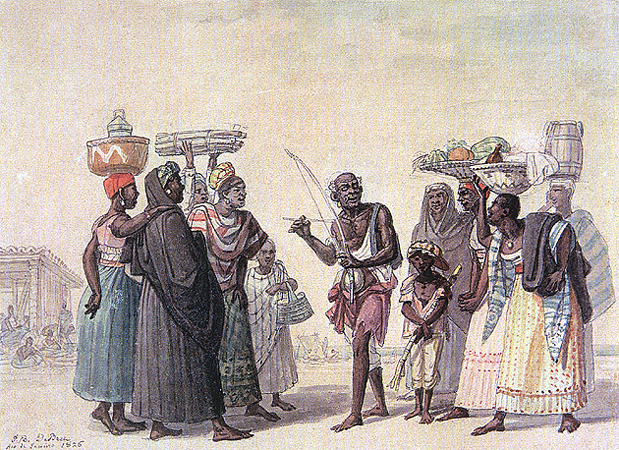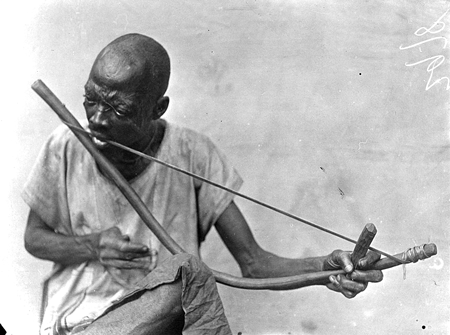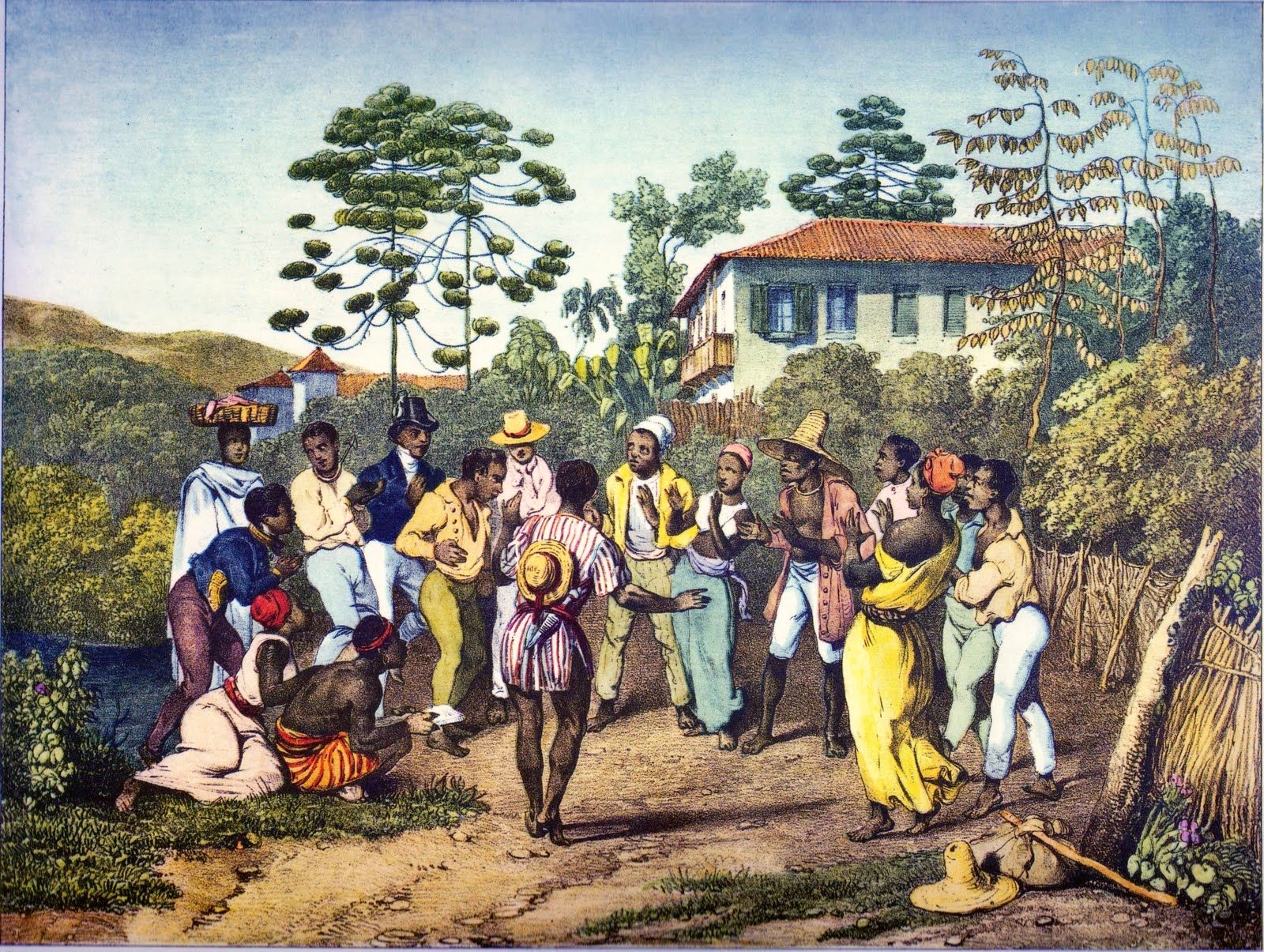|
Berimbau
The berimbau (, borrowed from Kimbundu ''mbirimbau'') is a traditional Angolan musical bow that is commonly used in Brazil. It is also known as ''sekitulege'' among the Baganda and Busoga. It consists of a single-stringed bow attached to a gourd resonator and is played with a stick and a coin or stone to create different tones and rhythms. The berimbau was used in many parts of Africa and Brazil during the 19th century to accompany chants and storytelling. It is part of the candomblé tradition, later incorporated into the Afro-Brazilians, Afro-Brazilian art capoeira. Until the mid-20th century, it was used almost exclusively within the black community, but after the popularization of capoeira, it gain wider popularity. Today, berimbau is used in various genres of popular music. History Berimbau is an adaptation of African gourde musical bows, as no Indigenous peoples in Brazil, Indigenous Brazilian or European people use musical bows. According to the musicologist Gerard K ... [...More Info...] [...Related Items...] OR: [Wikipedia] [Google] [Baidu] |
Capoeira
Capoeira () is an Afro-Brazilian martial art and game that includes elements of dance, acrobatics, capoeira music, music, and spirituality. It likely originated from enslaved Mbundu people, of the Kingdom of Ndongo, in present-day Angola. The Mbundu of Ndongo had a formal military in which soldiers were professionally trained for combat. When Mbundu people were captured and sold into the Atlantic Slave Trade, they would have brought these fighting abilities with them to Brazil, where it developed into Capoeira. It is known for its acrobatic and complex manoeuvres, often involving hands on the ground and inverted kicks. It emphasizes flowing movements rather than fixed stances; the ''List of capoeira techniques#Ginga, ginga'', a rocking step, is usually the focal point of the technique. Though often said to be a martial art disguised as a dance, capoeira served not only as a form of self defense, but also as a way to maintain spirituality and culture. Capoeira has been practic ... [...More Info...] [...Related Items...] OR: [Wikipedia] [Google] [Baidu] |
Musical Bow
The musical bow (bowstring or string bow, a subset of bar zithers) is a simple string instrument used by a number of African peoples as well as Indigenous peoples of the Americas. It consists of a flexible, usually wooden, stick 1.5 to 10 feet (0.5 to 3 m) long, and strung end to end with a taut cord, usually metal. It can be played with the hands or a wooden stick or branch. It is uncertain if the musical bow developed from the hunting bow, though the San or Bushmen people of the Kalahari Desert do convert their hunting bows to musical use. Types of bow include mouth-resonated string bow, earth-resonated string bow, and gourd-resonated string bow. History There is speculation that the hunting bow may have been used as a musical instrument from as early as circa 13,000 B.C. Henri Breuil surveyed the Trois Frères in France caves and made an engraving that attempted to reproduce a c. 13,000 B.C. cave painting into a black-and-white lithograph engraving. His engra ... [...More Info...] [...Related Items...] OR: [Wikipedia] [Google] [Baidu] |
Belembaotuyan
The eleaotua is a musical bow played in Guam, also spelled ''eluaotuas'', ''eleaotuchan'', and ''elimau-tuyan''. This gourd-resonating musical bow likely has common roots with the Brazilian berimbau, due to constant trade between Asia and South America in the nineteenth century, during which the instrument may have been introduced to the Chamorro people.{{cite web , url=http://www.guampedia.com/belembaotuyan-2/ , title= Belembaotuyan , last=Pangelinan, first=Therese Q. Crisostomo, date=July 14, 2014 , website=guampedia.com, publisher= , accessdate=2015-01-22 The instrument also resembles various zither/boat lutes found throughout Southeast Asia (esp. in the Philippines) called kutiyapi. Description The ''eleaotua'' has traditionally been part of wedding and other ceremonies in Guam, such as the Chamorro Month celebrations in schools, though it has lost popularity in recent times. The name of the instrument comes from the words ''eleao'' ('swaying of the trees' in Chamorro) and ... [...More Info...] [...Related Items...] OR: [Wikipedia] [Google] [Baidu] |
Kalumbu
The kalumbu, or kalumbo, is a traditional instrument of the Tonga and Ila people of Zambia and Zimbabwe. A single metal-stringed bow played with a stick is lashed onto a calabash gourd that acts as a resonating chamber. The kalumbu player manipulates the resonance of the instrument by moving the gourd toward and away from his or her chest. Though now quite rare in Africa, the kalumbu is considered the predecessor of the Afro-Brazilian berimbau used in Capoeira performances. A similar instrument, the ''dende'', is played by children in Botswana. The berimbau The berimbau (, borrowed from Kimbundu ''mbirimbau'') is a traditional Angolan musical bow that is commonly used in Brazil. It is also known as ''sekitulege'' among the Baganda and Busoga. It consists of a single-stringed bow attached to a gourd ... of Brazil is another similar instrument. References Musical bows Zimbabwean musical instruments {{Composite-instrument-stub ... [...More Info...] [...Related Items...] OR: [Wikipedia] [Google] [Baidu] |
Afro-Brazilians
Afro-Brazilians (; ), also known as Black Brazilians (), are Brazilians of total or predominantly Sub-Saharan African ancestry. Most multiracial Brazilians also have a range of degree of African ancestry. Brazilians whose African features are more evident are generally seen by others as Blacks and may identify themselves as such, while the ones with less noticeable African features may not be seen as such. However, Brazilians rarely use the term "Afro-Brazilian" as a term of ethnic identity and never in informal discourse. '' Preto'' ("black") and '' pardo'' ("brown/mixed") are among five ethnic categories used by the Brazilian Institute of Geography and Statistics (IBGE), along with '' branco'' ("white"), '' amarelo'' ("yellow", ethnic East Asian), and '' indígena'' (indigenous). In the 2022 census, 20.7 million Brazilians (10,2% of the population) identified as ''preto'', while 92.1 million (45,3% of the population) identified as ''pardo'', together making up 55.5% of Brazil's ... [...More Info...] [...Related Items...] OR: [Wikipedia] [Google] [Baidu] |
Batuque (Brazil)
Batuque (drumming) was a general term for various Afro-Brazilian practices in the 19th century, including music, dance, combat game and religion. ''Batuques'', or drumming ceremonies were an important cultural activity among the African population. These performance circles were a regular occurrence on Sunday evenings and holidays, drawing large crowds of enslaved Africans. Laws introduced in 1822 allowed police to shut down ''batuques''. Despite the police repression, the batuques persisted covertly at the town's outskirts or along the shoreline. Africans devised tactics to safeguard the batuques. They would scatter when the police approached and reconvene elsewhere to resume. In some cases, they responded to police repression with violence. Within the ''batuques'' gatherings, there were specific groups dedicated to a combat game known as ''pernada'' in Rio and ''batuque'' or ''batuque-boi'' in Salvador. In Bahia, the batuque dance evolved into various forms of samba, whil ... [...More Info...] [...Related Items...] OR: [Wikipedia] [Google] [Baidu] |
Brazilian Portuguese
Brazilian Portuguese (; ; also known as pt-BR) is the set of Variety (linguistics), varieties of Portuguese language native to Brazil. It is spoken by almost all of the 203 million inhabitants of Brazil and widely across the Brazilian diaspora, today consisting of about two million Brazilians who have emigrated to other countries. With a population of over 203 million, Brazil is by far the world's largest List of Portuguese speaking countries, Portuguese-speaking nation and the only one in the Americas where Portuguese, of which Brazilian Portuguese is a variety, is the official language under Article 13 of the Constitution. The Academia Brasileira de Letras (ABL) plays a significant cultural role in its development but has no legal regulatory authority over the language, which is shaped primarily by usage and educational norms in Brazil. Brazilian Portuguese differs notably from European Portuguese in phonetics, vocabulary, and grammar, though it remains a variety of Portuguese ... [...More Info...] [...Related Items...] OR: [Wikipedia] [Google] [Baidu] |
Batuque (game)
Batuque (drumming) was a general term for various Afro-Brazilians, Afro-Brazilian practices in the 19th century, including music, dance, Combat sport, combat game and religion. ''Batuques'', or drumming ceremonies were an important cultural activity among the African population. These performance circles were a regular occurrence on Sunday evenings and holidays, drawing large crowds of enslaved Africans. Laws introduced in 1822 allowed police to shut down ''batuques''. Despite the police repression, the batuques persisted covertly at the town's outskirts or along the shoreline. Africans devised tactics to safeguard the batuques. They would scatter when the police approached and reconvene elsewhere to resume. In some cases, they responded to police repression with violence. Within the ''batuques'' gatherings, there were specific groups dedicated to a combat game known as ''pernada'' in Rio de Janeiro, Rio and ''batuque'' or ''batuque-boi'' in Salvador, Bahia, Salvador. In Bahia ... [...More Info...] [...Related Items...] OR: [Wikipedia] [Google] [Baidu] |
Malunga
The ''malunga'' is a single-stringed musical bow played by the Siddi of India, who are the descendants of East African immigrants. It produces two tones, an octave apart, and the knuckle of the hand supporting the instrument may be pressed against the string to vary the pitch. It is struck with a stick and, as with the ''berimbau'' of Brazil, the hand holding the stick also holds a rattle (in the case of the ''malunga'' the rattle, called ''mai misra''). The ''malunga'' has a gourd resonator which amplifies the instrument's sound. The placement of this rattle along the string also varies the pitch produced by the Malunga. Construction The bow is made of solid-core bamboo cane, and the string is made of three twisted strands of gut. The gourd resonator is made from a coconut shell and is a mobile part of the instrument. Cultural importance The ''malunga'' is one of the instruments that is used in the religious practices of the Siddi people in India. This instrument is one of the ... [...More Info...] [...Related Items...] OR: [Wikipedia] [Google] [Baidu] |
Quijongo
The quijongo is a type of musical bow used by the indigenous peoples of Nicaragua and Costa Rica. In some countries, such as El Salvador, it is known as the carimba. It was probably used by the indigenous Chorotega people of Nicoya. It consists of a bow measuring 140cm in length, made of flexible wood with a string (generally metal) stretched between its ends. At a point a third of the way between its ends, a jicara or calabaza Calabaza is the generic name in the Spanish language for any type of winter squash. Within an English-language context it specifically refers to the West Indian pumpkin, a winter squash typically grown in the West Indies, tropical America, and t ... gourd is affixed to serve as a resonator. Sound is created by striking the string with a stick, and the tone can be modulated by covering and uncovering the soundhole in the resonator with the fingers, changing the tone by a fourth or sixth. Occasionally, it is amplified by placing the base of the bow ... [...More Info...] [...Related Items...] OR: [Wikipedia] [Google] [Baidu] |
Europe
Europe is a continent located entirely in the Northern Hemisphere and mostly in the Eastern Hemisphere. It is bordered by the Arctic Ocean to the north, the Atlantic Ocean to the west, the Mediterranean Sea to the south, and Asia to the east. Europe shares the landmass of Eurasia with Asia, and of Afro-Eurasia with both Africa and Asia. Europe is commonly considered to be Boundaries between the continents#Asia and Europe, separated from Asia by the Drainage divide, watershed of the Ural Mountains, the Ural (river), Ural River, the Caspian Sea, the Greater Caucasus, the Black Sea, and the waterway of the Bosporus, Bosporus Strait. "Europe" (pp. 68–69); "Asia" (pp. 90–91): "A commonly accepted division between Asia and Europe ... is formed by the Ural Mountains, Ural River, Caspian Sea, Caucasus Mountains, and the Black Sea with its outlets, the Bosporus and Dardanelles." Europe covers approx. , or 2% of Earth#Surface, Earth's surface (6.8% of Earth's land area), making it ... [...More Info...] [...Related Items...] OR: [Wikipedia] [Google] [Baidu] |
Candomblé
Candomblé () is an African diaspora religions, African diasporic religion that developed in Brazil during the 19th century. It arose through a process of syncretism between several of the traditional religions of West and Central Africa, especially those of Yoruba religion, the Yoruba, Bantu mythology, Bantu, and Gbe languages, Gbe, coupled with influences from Roman Catholicism. There is no central authority in control of Candomblé, which is organized around autonomous ''terreiros'' (houses). Candomblé venerates spirits, known varyingly as ''Orisha, orixás'', ''inkice'', or ''vodun'', which are deemed subservient to a transcendent creator god, Olorun, Oludumaré. Deriving their names and attributes from traditional West African deities, the ''orixás'' are linked with Roman Catholic saints. Each individual is believed to have a tutelary ''orixá'' who has been connected to them since before birth and who informs their personality. An initiatory tradition, Candomblé's member ... [...More Info...] [...Related Items...] OR: [Wikipedia] [Google] [Baidu] |





